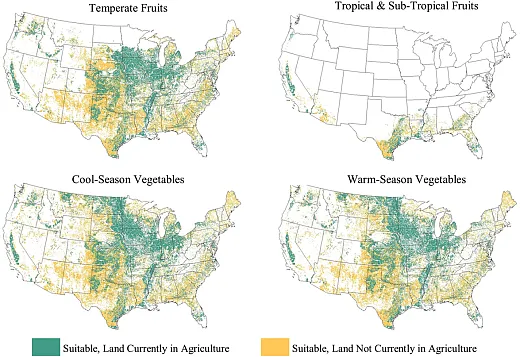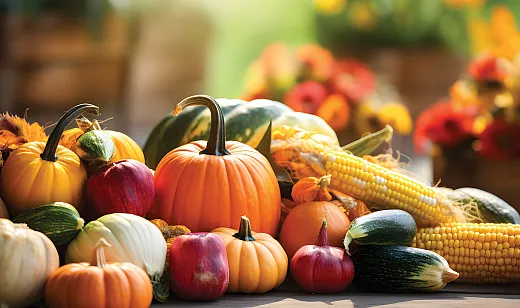The Supply and Demand of Green Eating

Most of us want to eat healthy to take care of our bodies. With climate change, more people are also aware that food choices impact the planet’s health, too. But what will it take to get people to eat significantly more fruits and veggies? And could agriculture adapt if aspirational appetites became reality? Here, featuring recent science from Agronomy Journal, we look at sustainable eating from the perspectives of both supply and demand and consider how government guidelines shape conversations and behaviors around food.

Most of us want to eat healthy to take care of our bodies. With climate change, more people are also aware that food choices impact the planet’s health, too. But what will it take to get people to eat significantly more fruits and veggies? And could agriculture adapt if aspirational appetites became reality? Here, featuring recent science from Agronomy Journal, we look at sustainable eating from the perspectives of both supply and demand and consider how government guidelines shape conversations and behaviors around food.
We’ve all gotta eat, but eating is a two‐way street. We don’t just consume food; it consumes us. It sucks up our time (grocery shopping, prep, eating, and cleaning), our money (more than 10% of the typical American household budget), our land (agriculture accounts for 38% of land use globally and half in the United States), and our water (70% of fresh water withdrawals worldwide). Our cultures are rooted in food and our emotions entwined with it, like chocolate in fudge ripple ice cream. Food intersects with almost every aspect of our lives.
So, it’s no surprise that it has a whopping environmental footprint. According to the United Nations, about a third of human‐caused greenhouse gas (GHG) emissions are linked to food. While there are many aspects of food production that generate GHG, this story focuses on the choices we make when we load up our plates.
Let’s grab the bull by the horns and start with the usual suspect, beef. For example, one kilogram of beef generates 70.6 kg of GHG, according to the UN report, many times more than poultry (9.9 kg), tofu (3.2 kg), or veggies (0.7 kg). Factor in the protein punch beef delivers, and its environmental impact is still hefty: 35.5 kg of GHG per 100 g of protein compared with 5.7 kg for poultry and 2 kg for tofu.
Not to worry, steak lovers: There will be no bovine bashing here. In fact, Ashley McCarthy, a food scientist whose research we’ll learn about later in the story, was raised on a Nebraska beef farm.
“I grew up in a family that ate very much meat and potatoes, and meat was by far the biggest component of the plate,” says McCarthy, a postdoctoral associate at the University of Vermont’s (UVM) Department of Nutrition and Food Sciences.
McCarthy still enjoys a good ribeye now and again. But she says we need to change how we eat for both personal and planetary health: less meat and more veggies, fruits, and whole grains.

Nutritionist Becky Ramsing agrees. “We need to do something for how we eat and consume food,” says Ramsing, a senior program manager at the Johns Hopkins Center for a Livable Future. She is approaching the problem from the behavioral side: How do you convince people to “eat green” and consume healthier, more sustainable foods? Let’s first learn about Ramsing’s work on increasing demand for healthier foods, and then check back in with McCarthy to talk supply: Where would all that produce come from, anyway?
Demand: Creating an Appetite for Healthier Food
The USDA has graded Americans on how they eat, and the news is a bit embarrassing: The average American diet scores a D± (59 out of 100) on their Healthy Eating Index, which compare’s actual food consumption to federal dietary guidelines.
There are some glaring gaps. According to research cited by McCarthy in Agronomy Journal earlier this year (https://doi.org/10.1002/agj2.21305), Americans would need to boost their fruit intake by 136% and vegetables by 71% to meet the nation’s guidelines.
Changing engrained and complex behaviors is no easy task, especially when it comes to food. How to do that is the focus of Ramsing’s work. In an article published earlier this year in Frontiers in Sustainable Food Systems, she and her colleagues compared two types of strategies for getting college students to eat healthier. In this study, that meant consuming less meat.
Changing engrained and complex behaviors is no easy task, especially when it comes to food.
The first type of strategy is called choice architecture. That includes manipulating menus, upping the number of meatless choices, and modifying restaurant layouts to make the plant‐based choice stand out more. These strategies work subconsciously to make the healthy choice the easier choice. Ramsing calls these “nudges.”
The second approach targets the conscious brain by providing information about why the healthier choice is better. This could be promotional messaging, labeling, or enticing pricing.
The researchers discovered that choice architecture interventions were more effective than those targeting conscious decision‐making. But the most successful approaches combined both strategies.
“Food is much more complicated than a lot of decisions because it’s all about preference and culture and taste—and everything,” says Ramsing, who addressed the topic of food choices and health at the Societies’ 2022 Annual Meeting. “So those two [strategies] working together seem to really make the difference of shifting consumer choices and shifting them more long term.”
When it comes to food and feelings, meat takes the cake, Ramsing says. It has strong associations with wealth, masculinity, hospitality, and strength across many cultures. For that reason, messages about eating less of it must be carefully crafted. “That message of ‘all or nothing’ doesn’t work,” she says. “Small changes really work.”
Ramsing also tries to avoid labels like “vegetarian” or “vegan.” Her bottom line: “Let’s just try to do better most of the time.”
Labels can also be misleading. While “vegetarian” might sound more planet‐friendly than being an omnivore, it isn’t necessarily. Diets that included animal products for only one meal per day were less GHG intensive than vegetarian diets that included eggs and milk products, according to a 2019 Johns Hopkins study.
So, what works best? The “health message” resonates more than the “climate message,” including with young adults, Ramsing says. “Even among that population, health is a driver,” she says. “It may not be health in terms of heart disease or diabetes, but it might be fitness, memory, healthy weight, and such.”
Steering people toward healthier foods is likely to be on ongoing challenge: Americans are fickle foodies. A visualization on the blog FlowingData illustrates how tastes have evolved over decades as chicken overtakes first pork, then beef, to become the nation’s favorite meat; whole milk falls out of favor, dropping from first to fourth place in dairy choices; and dark greens jump from seventh to second place under veggies.
Many of those changes have been positive for both human bodies and the planet. Also, there’s evidence that more people are shifting to a plant‐based diet. Sales of those foods grew 45% between 2019 and 2022, according to the Plant Based Foods Association. The proliferation of cleverly named options—from Fakin’ Bacon, Chik’n Nuggets, and Beyond Burgers to Smart Dogs, Tofurky, and the oxymoronic Meatless Meatballs—is evidence of the trend.
But if demand for veggies and fruits expands, will agriculture be able to keep up? That’s a great question, and one that UVM’s McCarthy is shaping her career around. Compared to creating an appetite for greener food, she thinks she has the easier job. “I’m so glad other people work on trying to get people to do that,” McCarthy says, “but I think it’s a very difficult thing to do.”
Supply: Where to Grow More Fruits and Veggies
What if everyone drank the kombucha and began eating all the fruit and veggies they’re supposed to? That question launched a thought experiment that undergirded McCarthy’s Ph.D. dissertation at Tufts University: Could the U.S. even grow all the fruits and veggies needed to meet that theoretical demand?
For much of the country’s history, this was not a hypothetical: The nation, and individual regions within it, had no choice but to produce all their own food. But with westward expansion, the railroad system, refrigeration, technology, and globalization, self‐reliance became a thing of the past, McCarthy explains.
Today, about half the fruits and 30% of the vegetables Americans consume are imported, most from Mexico and Canada, according to McCarthy’s Agronomy Journal paper. Sliced another way: The U.S. produces enough fruit to meet only 67% of current demand although it does grow enough veggies to meet the population’s relatively anemic appetite for that food group. If, per McCarthy’s thought experiment, Americans suddenly began to ingest all the broccoli, beets, mangos, and cherries its government recommends, current domestic production would cover just 29% of that fruit and 53% of the veggies.

That discrepancy could lead to problems in the future, something McCarthy sought to explore in her research. She also wanted to look at how specific regions would fare under the eat‐your‐veggies scenario, given that so much of American produce is now consolidated in areas like California, the source of half of all fruits and veggies grown in the U.S.
“We have developed a system of producing food in this country that’s very geographically concentrated in specific places,” McCarthy says, “and that could increase our vulnerability to things like climate change and natural resource shortages.”
Another concerning trend: Agricultural land overall is declining in the U.S. Urbanization is claiming prime farmland ideal for fussy fruits and veggies, which unlike some other crops, have rigid climate and soil requirements.
As a first step in this research project, McCarthy conducted a land suitability study, published last year in Agronomy Journal (https://doi.org/10.1002/agj2.21138). The driving question behind the paper: Does the U.S. have enough land to grow all its fruits and vegetables?
After examining climate, soils, topography, and other biophysical aspects of the land, McCarthy and her coauthors had good news: There is a “tremendous” amount of land suitable for fruit and veggie production—more than 300 million hectares in the contiguous states. Of that, less than half is currently used for agriculture. What’s more, that land is well distributed across the country.
That led to McCarthy’s next question, addressed in her second Agronomy Journal paper published this year: Could the U.S. actually supply all its own fruits and veggies using that land, without depending on imports?
Again, McCarthy and her coauthors had good news: By and large, the U.S. could meet that goal. And not only for current levels of consumption: Even if every American lived up to federal dietary ideals, the nation could still produce all those recommended fruits and veggies.
The effort would, though, require more than doubling the land devoted to those crops—from the 4.7 million hectares (3% of all current cropland) now used to 12.2 million hectares (7.5% of cropland), according to the study. And though some foods, such as subtropical and tropical fruits, would be off the menu in certain areas, there is enough suitable land within each region for all of them to be self‐sufficient.
McCarthy notes that, as a thought experiment, the analysis is limited: It did not consider water, for example, a critical but complicated factor that varies across the year. “That’s something we’d like to try to keep working on in the future,” she says.
Another limitation was the study’s use of historical climate data. “We know our climate is changing, so we need to add on projections of what climate will look like in the future,” McCarthy says, “to think about where we could grow different types of fruits and vegetables under the predicted conditions that we’ll be facing.”
Refining the analysis by factoring in climate change, water availability, and resources like labor and fertilizer will likely reduce the amount of suitable land, says McCarthy, who has plans to incorporate additional factors in the future.
Broadening the Conversation Around Food
By design, McCarthy’s studies raise lots of questions. Should self‐reliance be a goal, or should the nation continue to import some food? Do imports unfairly foist environmental burdens on trade partners? What are the economic implications of shifting these balances? What land should be preserved now for farming fruits and veggies in the future? Will climate change steer the U.S. toward regional food systems?
That last question is particularly compelling to McCarthy, who sees regional systems as a path to food resilience. “The ultimate idea is to be able to identify places where we can actually establish new supply chains,” she says, “hopefully in a more regionalized manner or a more geographically diverse manner than we currently do.”
One great example of that work already underway, McCarthy says, is the Eastern Broccoli Project. At a time when more than 90% of broccoli in the U.S. is grown in California, the Cornell University‐based effort aims to create a regional supply chain for the crunchy cabbage on the other side of the continent. One of the chief hurdles is that existing cultivars are bred for the Golden State. The East Coast team is breeding more heat‐tolerant varieties of this cool‐season veggie with a promising new variety now undergoing commercial trials.
Broccoli is one of those veggies nutritionists would love us to eat more of: A single cup delivers all the vitamin C and K we need in a day, according to U.S. dietary guidelines. Currently, those guidelines focus on what’s healthy for people, not the planet. But some nutritionists argue that sustainability should play a role in U.S. dietary guidelines as it does in some other countries. Canada’s Dietary Guidelines, for example, cite evidence that eating more plant‐based and less animal‐based foods helps conserve soil, water, and air.

In the U.S., the USDA and Department of Health and Human Services update dietary guidelines every five years; the recommendations now under development are scheduled to come online in 2025. But those are unlikely to address food’s environmental impact, says Ramsing, because the topic is not among the scientific questions that the advisory committee drafting the updates is authorized to consider. Current guidelines also lump red meat, poultry, and eggs together in the protein group, making it difficult to address nutritional or environmental differences among those subcategories, including evidence that processed meats are linked to cancer and other negative outcomes, Ramsing says.
“They are not bringing sustainability into this conversation,” Ramsing says. “But we can’t separate those two. We need to keep health and our planetary health and sustainability together.”
DIG DEEPER
McCarthy, A. C., Griffin, T. S., Srinivasan, S., & Peters, C. J. (2023). Capacity for national and regional self‐reliance in fruit and vegetable production in the United States. Agronomy Journal, 115, 647– 657. https://doi.org/10.1002/agj2.21305
McCarthy, A. C., Srinivasan, S., Griffin, T., & Peters, C. J. (2022). A geospatial approach to identifying biophysically suitable areas for fruit and vegetable production in the United States. Agronomy Journal, 114, 2845–2859. https://doi.org/10.1002/agj2.21138
Ramsing, B. (2022) Balancing the consumer’s role in a sustainable food system vis‐à‐vis the complex and multi‐layered determinants of food choices [Paper presentation]. ASA, CSSA, and SSSA International Annual Meeting, Baltimore, MD. https://scisoc.confex.com/scisoc/2022am/meetingapp.cgi/Paper/142280
Text © . The authors. CC BY-NC-ND 4.0. Except where otherwise noted, images are subject to copyright. Any reuse without express permission from the copyright owner is prohibited.










